Soon after the start of the corona pandemic, the Associação Brasileira de Linguística (ABRALIN) initiated a virtual lecture and workshop series entitled Abralin ao Vivo: Linguists Online. The many wonderful contributions, from budding local talents to international celebrities (including Peter Bakker from Denmark), have been recorded on the website and can be watched again. Brazil is of course well represented in the program, and the indigenous languages are often featured. Brazil has up to 160 different Amerindian languages, of which around 120 are spoken in the Amazon. Virtually all of Brazil’s indigenous languages are in danger of extinction due to factors such as the small size population groups, the appeal of the Portuguese language, and the physical destruction of the indigenous areas. Now an extra factor has been added: the coronavirus SARS-CoV-2. In mid-October 2020, I had the honor to participate in an Abralin round table discussion about the impact of Covid-19 in Peru and Brazil on the indigenous languages.
It’s nothing new to the indigenous peoples of South America, such a deadly virus. The languages I study are spoken in the southwestern Amazon by small population groups who only came into contact with Europeans and their descendants a century ago. The newcomers often brought with them exotic diseases such as influenza, tuberculosis, measles, smallpox, chicken pox, etc. The local populations had little resistance to these diseases, and the measles could have as devastating effects as the medieval bubonic plague in Europe. The ancestors of the indigenous people left the Eurasian continent at least 15,000 years ago, and resistance to the diseases of the Old World has not been built up since then. My older indigenous informants (you can’t use that word anymore these days, but I think “collaborators” is also a lousy word) remember well the early period of contact with rubber tappers. Their people died quickly and in great numbers, and so they fled into the forest to other settlements. In this way, the disease sometimes spread over large areas. Many were left to die along the trail. The flight into isolation only made sense for those who were not already infected.
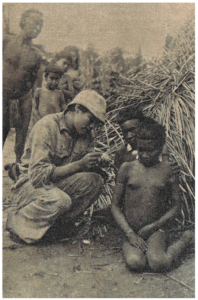
It is estimated that there are more than a hundred isolated groups living in the Amazon. Linguists would like to know what languages those groups speak, missionaries sometimes want to try to move into their territories in order to liberate the inhabitants very romantically from Satan’s clutches, lumberjacks love to obtain their wood, prospectors come for the gold, and the cattle and soy farmers want the land. After the end of the Brazilian dictatorship, a progressive constitution was drawn up in 1988, guaranteeing indigenous peoples the right to their own areas, languages and cultures. In the case of isolated peoples, the rule is that they themselves must take the initiative if they want to contact the “outside world”. It is forbidden to contact them. If contact seems unavoidable, the government can contact them as a precaution. If contact is initiated, vaccination will be the first on the program. Friends who work in the Índios Isolados (“isolated Indians”) branch of FUNAI, the governmental agency for the protection of the indigenous peoples, told me how they inject themselves regularly with distilled water so as to make it clear that this is part of the introductory ritual.
On March 25, 2020, less than a week after the first corona infection in Brazil, a young indigenous woman of the Kukama ethnic group died of the corona virus, in Santo Antônio do Iça, in the west of Amazonas state. She was an indigenous health care worker. It has not been disclosed whether she was also a speaker of the Kukama language, a language of the Tupi-Guarani language family. Soon after this, infections and deaths began to increase. A few weeks later, an old acquaintance of mine in the Amazon city of Manaus died of corona. Aldevan Baniwa was also a native health care worker and he traveled extensively fighting endemic diseases. He spoke several Amerindian languages, including Nheengatu, also related to the Tupi-Guarani family. By the way, both Kukama and Nheengatu have been strongly affected by the consequences of language contact. There is an interesting discussion going on about whether these two languages are creole languages (Bakker 2014, 2020, Moore 2014, Vallejos 2016). This is extra exciting because indigenous creole languages in South America are a rarity. Aldevan had only recently started to publish multilingual popular science work. There is a page dedicated to him and his work on the Etnolingüística website.
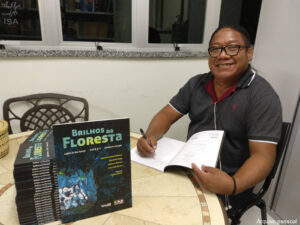
The corona epidemic is raging and it has also reached the peoples of the state of Rondônia where I regularly do linguistic fieldwork. Rondônia is ecologically one of the most devastated areas of the Amazon basin. Language diversity is exceptionally great, but it is seriously threatened. The population groups are relatively small and as a consequence of the increasing dominance of Portuguese, the number of speakers of the indigenous languages is sometimes much smaller. For example, of the approximately 50 remaining Kwaza, only half speak the language (Kwaza is an isolate, which means that it is a language family in itself), of the 310 registered Kanoé only five speak their language (also an isolate), and of the approximately 40 Arikapú, only one person speaks the language (a Macro-Jê language). The last speakers are often older people, or sometimes they are people who have only recently come into contact with the surrounding Western culture. In such cases, an indigenous language can actually become extinct as a direct result of the corona epidemic.
But before a language disappears, the epidemic can already cause irreparable damage. Of the approximately 400 Aikanã, there are about 250 who speak the Aikanã language (an isolate also known as Massaka or Huari). Although the language is still being passed on to the youngest generations and even though it is even acquiring new domains of use, such as social media, areas associated with traditional culture are disappearing. Older people who were born in traditional times often remember the old myths and sagas, and they can sometimes still tell the stories and traditions, or at least they can interpret the meaning of the events. The last shaman of the Aikanã died in 1986. His widow still knows a number of ritual chants, she can explain what they mean and she knows the specialist vocabulary of traditional medicine. Her children and grandchildren, however, watch soap operas on TV, listen to modern Brazilian country & western schlagers, and go to church.
On October 5, 2020, José Pe’i Aikanã died of corona at the age of about 80. As a young boy, he had been subjected to the initiation rituals of the Aikanã and had learned how to play the traditional purikɨi flute in the process. This is a bamboo flute with four fingering holes, and it is one of the original musical instruments of the Aikanã, in addition to different types of whistles, horns and rattles.

The purikɨi flute is special because it represents the spirits of the primeval fathers. It was mainly played at the initiation of boys and in shamanic sessions. Women were not allowed to see or hear the purikɨi. The music of the purikɨi is also very special, because the sound represents words: songs and parts of the origin stories. You have to take that very literally. The songs are not sung, but whoever knows them could in principle sing along. I have been able to make several recordings of Pe’i’s flute playing, and afterwards record the accompanying songs that were sung during playback. Nowadays, hardly anyone knows the flute songs, and unfortunately Pe’i has not been able to pass the flute playing on to anyone. In the current Aikanã community, this tradition no longer has a relevant function. In the 1960s, purikɨi flute playing had already become a beautiful sentimental memory of a group of adults who had learned it in its original function. One by one these men have since died, and with José Pe’i Aikanã, the corona epidemic has put an end to this special verbal art.
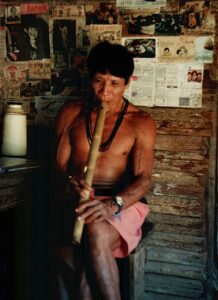
The statistics kept by the APIB Indigenous Peoples Association of Brazil, the Articulação dos Povos Indígenas do Brasil, show how many people have been infected by state and how many of which population group died from it and when. The graphs clearly show the first wave, which ran approximately until October 2020. Those who live in the reservations have an advantage: they can withdraw and keep their distance from the rest of the world, especially if they still have some degree of self-sufficiency. In addition, since March 2020, the government has prohibited outsiders from entering the reserves, even if they have an official FUNAI authorization. Until everyone has been properly vaccinated, keeping your distance is the best protection against the virus.
Various organizations and individuals have set up campaigns to provide indigenous peoples with reliable information. This can also be done in the indigenous languages, and a good example is the leaflets of the Yanomami Association Hutukara, in collaboration with the Instituto Socioambiental.
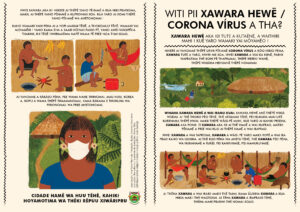
Despite the fact that Bolsonaro’s federal government has an ambivalent attitude to the pandemic and the vaccine, to say the least, the state governments want to vaccinate everyone as soon as possible. The indigenous populations, including the Warao Indians who have fled Venezuela (they speak an isolated language), have priority, in addition to the elderly. The first shipments of vaccines were delivered in January 2021 and the campaign has started.
There are people who think that the virus is insignificant, or even a conspiracy. From the beginning, President Bolsonaro has pretended that it was an ordinary flu. His response to a question about the many victims: “Well, everyone will die at some point. What should I do about it? I’m not a gravedigger, am I? ” In the meantime, nearly a quarter of a million Brazilians have died from the corona virus. The national health system SUS has the proven capacity to vaccinate 10 million people per day, and the world-renowned Butantan serum institute in São Paulo has developed the Coronavac vaccine in collaboration with Chinese laboratories. That vaccine has now also been approved by the responsible Brazilian medical authority, but unfortunately Bolsonaro has started a personal argument with Chinese President Xi Jinping. He does not want to buy the “Chinese” vaccine and he is freeing up millions for Ivermectin (a de-worming cure) and Chloroquine (a malaria medicine). Researchers who have proven that this does not help against corona receive death threats from “Bolsonaristas”. At most, the president is willing to pay for the Oxford-AstraZeneca vaccine, for those weaklings who are afraid of such a flu virus.
Bolsonaro pursues disgraceful policy of degradation in areas concerning the environment, education, science, culture and social services. He is of the opinion that the indigenous peoples should assimilate and he is constantly trying to undermine their rights. Violations of protective laws are tolerated in practice. These Indians, they don’t want to live like wild animals in the forest, now do they? He has a large following with the agricultural lobby, the miners and the evangelical churches. Lately, evangelical fundamentalists have been addressing indigenous peoples via social media with the message that vaccination is unsafe. They give admonishing sermons or sometimes tearful litanies, claiming that the vaccine comes from Satan, that only God can heal you, and that those who get vaccinated will face a terrible fate. Such false prophecies are spreading rapidly. Fortunately, there are also people who argue against it with rational arguments. For example, the linguist Luciana Storto, known for her extensive work on Karitiana (a Tupi language), made a video in which she explains very calmly what the vaccine is and that people should not believe the evangelical smear campaign. I have shared the video with my indigenous acquaintances several times and the argument has been presented so well that I assume many will listen to her.
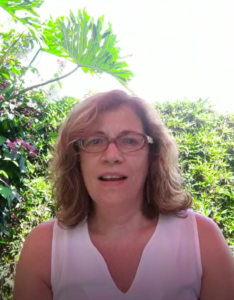
At the moment, the state of Amazonas is in the grip of the second wave, or rather a tsunami, with an extra contagious variant of the corona virus. If you count the 40% city-dwelling indigenous people, it is estimated that there are about 900,000 indigenous individuals in total in Brazil. It is not clear whether this total number is the basis for APIB’s count of the current 48,000 corona infections and the nearly 1,000 fatalities. So at least 5% of the indigenous population has become infected, of which about 2% have died. If these bare figures represent reality, then these percentages are roughly equal to what applies to the Brazilian population as a whole. Without a strict isolation policy, however, these would probably be much higher for the indigenous people. The figures in the cities show that the percentage of victims there is much higher among indigenous people than among non-indigenous people. It is to be hoped for the survival of both the people and the languages that the vaccination campaign will get under way soon.
Bakker, Peter. 2014. Creoles and typology: Problems of sampling and definition. In: Journal of Pidgin and Creole Languages, 29/2, p.437-455.
Bakker, Peter. 2020. The quest for non-European creoles: Is Kukama (Brazil, Peru) a creole language? In: Norval Smith, Tonjes Veenstra, Enoch Olade Aboh (eds.), Advances in contact linguistics: In honour of Pieter Muysken. Amsterdam / Philadelphia: John Benjamins, p.85-106.
Moore, Denny. 2014. Historical development of Nheengatu (Língua Geral Amazônica). In: Salikoko Mufwene (ed.), Iberian imperialism and language evolution in Latin America
Chicago: University of Chicago Press, p. 108-142.
Rondon, Cândido Mariano da Silva. 1946. Índios do Brasil: Do centro, noroeste e sul de Mato Grosso. Vol. I. Rio de Janeiro: Conselho Nacional de Proteção aos Índios / Ministério da Agricultura. [Heruitgave 2019 vrij toegankelijk via <https://www2.senado.leg.br/bdsf/handle/id/559114>]
Vallejos, Rosa. 2016. A grammar of Kukama-Kukamiria: A language from the Amazon. Leiden: Brill.
Hein van der Voort is a linguist. Since 1994 he has been working in the Amazon region on the documentation, analysis and description of indigenous languages, in particular those of the state of Rondônia. Since 2013 he is a permanent researcher at the Museu Paraense Emílio Goeldi in Belém, Brazil.







